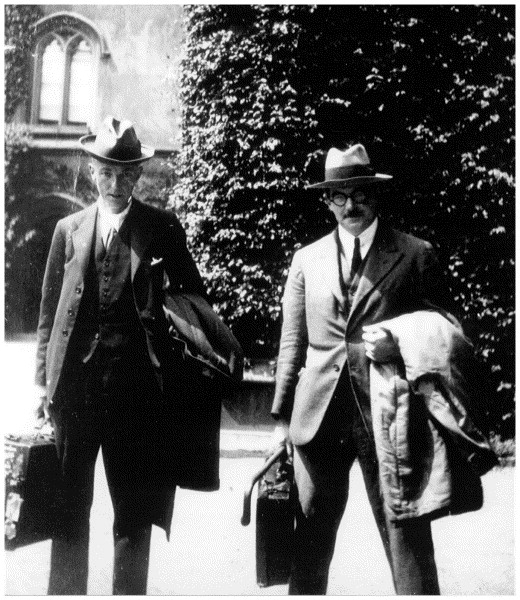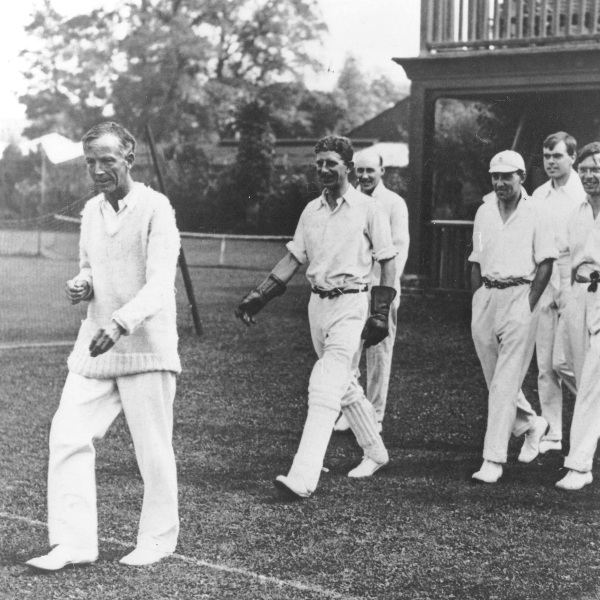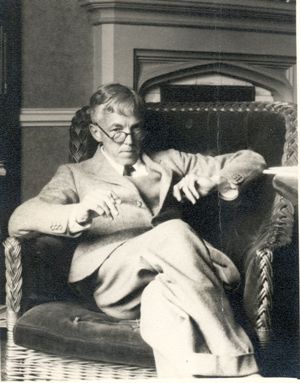
published 2016 by Cambridge University Press
421 pages
ISBN 9781107594647
Godfrey Harold Hardy (1877–1947) was one of the most influential mathematicians of the twentieth century. His research in mathematics was world class. Indeed, he received many honours for the quality of his mathematics, such as the Smith Prize, the Royal Medal, the De Morgan Medal, the Sylvester Medal, and the Copley Medal, to name a few. He was a Fellow of the Royal Society. His contributions laid the groundwork for much of what is now referred to as the analytic theory of numbers. After nearly one hundred years, his textbooks are still relevant, and in some cases arguably remain among the best in their field. His writings about mathematics are treasured works in which the aesthetics of mathematics and the “doing of mathematics” is portrayed in a way which inspires both amateurs and professionals alike. He was an ecumenical scholar who mingled with a vast array of the British intellectual elite of his day. His acquaintances included Harald Bohr, H.S.M. Coxeter, George Pólya, Bertrand Russell, C.P. Snow, E.C. Titchmarsh, to name a few. He was a complicated (but transparent) man who freely shared his carefully considered political and religious views. He was an eccentric man who scorned the practical “real world” but somehow made room in his life for a fanatical love of cricket. Hardy was a gift to the world of mathematics.
The G.H. Hardy Reader edited by Donald J. Albers, Gerald L. Alexanderson, and William Dunham is a delightful compilation of writings which offers a comprehensive look at the many facets of this intriguing man. These writings consist of excerpts of published material as well as personal letters. Most of the selections were written by Hardy, and these offer glimpses of his mathematics, his relationships with important figures in his life such as John Littlewood and Srinivasa Ramanujan, and his peculiar view of the world. Other articles include remembrances of Hardy by distinguished scholars such as Freeman Dyson and Norbert Wiener. Overall, this book is a captivating compendium of articles, essays, excerpts, and letters which offers a fascinating look at one of the world’s greatest mathematicians. This is a “must read” for anyone interested in the history of mathematics.
The first third of the book is devoted to Hardy’s life, and it consists of twelve separate selections which together provide various intriguing perspectives. Hardy was born in 1877 to an upper-middle class family in Cranleigh, Surrey, England. His father worked at the Cranleigh School, where he was the Bursar and Art Master. His mother was on the staff of Lincoln Training College for teachers. He had a sister Gertude he affectionately called “Gertie.” Despite a terrible accident in which Hardy hit Gertrude’s eye with a cricket bat resulting in the loss of the eye, the siblings would remain close until Hardy’s death in 1947.
Readers will enjoy selections which describe Hardy’s early life and career. He was a gifted young student, first at Cranleigh School and later the prestigious Winchester School, where he enjoyed a scholarship thanks to his mathematical abilities. Known as a training ground for boys aiming for admission to Cambridge and Oxford, the Winchester School was a perfect training ground for the young Hardy, who excelled in his coursework. In 1896, Hardy entered Trinity College at Cambridge where he quickly earned a reputation as a mathematical genius. After two years (instead of the customary three years), Hardy participated in the Mathematical Tripos winning fourth place Senior Wrangler. Although he would argue to abolish the Tripos years later, his performance was duly noted as extraordinary.

Readers will enjoy commentary about the unusual relationship between Hardy and Littlewood
The first part of the book offers intimate glimpses of Hardy’s life. Students of mathematics will find his transition from college student to young Cambridge Professor at Trinity College particularly interesting. In 1919 Hardy left Cambridge for Oxford, where he enjoyed the Savilian Chair in Geometry. He held this position until 1931 when he returned to Cambridge where he was the Sadleirian Professor until his retirement in 1942. Along the way, Hardy spent the 1928–29 academic year in Princeton in an exchange where Oswald Veblen took his place at Oxford. The Reader is flush with anecdotes about Hardy’s life. Readers will enjoy excerpts about his love of cricket, interest in American baseball and football, disdain for mutton, and his continuous “feud” with God.
Hardy’s relationships with Srinivasa Ramanujan and John Littlewood are prominent in the first part of this book. After a brief biography of Littlewood, readers will enjoy commentary about the unusual relationship between these two men. The two typically communicated by letter rather than in person despite the close proximity of their offices. They jointly ran a mathematics seminar but rarely attended together. Nevertheless, they wrote many research papers together including their seminal treatise on the “Hardy–Littlewood circle method” which was an outgrowth of Hardy’s work with Ramanujan on the partition function.
Ramanujan’s first letter to Hardy (apart from the pages of subsequent mathematical formulas), which introduced Ramanujan to the world of mathematics, is reproduced in its entirety. It is quite fitting to include this letter, for the historic text plays a central role in the lives of both men, and of course for the future of mathematics.
Part II of this book consists of writings by and about Hardy. This section of the book is brimming with delightful Hardy quotes about the aesthetics of mathematics, about the life of a mathematician, and of his life in particular:
Young men should prove theorems; old men should write books. (cf. p. 123)
Mathematics is an ancient, and one would have supposed quite a gentlemanly, study. (cf. p. 125)
… a book about mathematics without difficulties would be worthless. (cf. p. 130)
I know that there are emotions, many, for example, of the emotions inspired by music, which I am almost, if not quite, incapable of experiencing. (cf. p 132)
… I read the reports in the papers by the hour and worship Babe Ruth and Lou Gehrig. Batting averages ranging from .387 to .231 are very entertaining to a cricketer. (cf. p. 133)
Opinions may differ as to the importance of Ramanujan’s work, the kind of standard by which it should be judged, and the influence it is likely to have on the mathematics of the future. It has not the simplicity and inevitableness of the very greatest work; it would be greater if it were less strange. One gift it has which no one can deny, profound and invincible originality. He would probably have been a greater mathematician if he had been caught and tamed in his youth; he would have discovered more that was new, and that, no doubt, of greater importance. On the other hand he would have been less of a Ramanujan, and more of a European professor, and the loss might have been greater than the gain. (cf. p. 128)
I still say to myself when I am depressed, and find myself forced to listen to pompous and tiresome people, “Well, I have done one thing you could have never done, and that is to have collaborated with both Littlewood and Ramanujan on something like equal terms. (cf. p. 81)

Hardy was an eccentric man who scorned the practical “real world” but somehow made room in his life for a fanatical love of cricket
Part III of this book includes sixteen articles about mathematics. The editors of this volume presumably had a very difficult task of limiting their selections because of the sheer volume of Hardy’s collected works. The editors have chosen well. The selections include a healthy mix of expository articles and technical works intended for experts.
The first selection is a true gem; it is Hardy’s article, “An introduction to the theory of numbers”, which was published in the Bulletin of the American Mathematical Society in 1929. This paper was awarded the Chauvenet Prize for “Best Mathematical Exposition” by the Mathematical Association of America. In this article, Hardy begins with the story of John Farey, a Napoleonic era surveyor, a man who was best known as a “collector of minerals and rocks”. Hardy marvels and begins this article with the lovely story of beautiful mathematics discovered by the amateur Farey, the theory of Farey fractions, finite sequences of rational numbers between 0 and 1 whose denominators do not exceed a fixed positive integer n. For example, if n=7, then we have
\frac{0}{1}, \ \frac{1}{7}, \frac{1}{6},\ \frac{1}{5},\ \frac{1}{4},\ \frac{2}{7}, \frac{1}{3},\ \frac{2}{5},\ \frac{3}{7},\ \frac{1}{2},
\frac{4}{7},\ \frac{3}{5},\ \frac{2}{3},\ \frac{5}{7},\ \frac{3}{4}, \ \frac{4}{5},\ \frac{5}{6}, \ \frac{6}{7},\ \frac{1}{1}.
Hardy praises (and proves) the beautiful facts about consecutive Farey fractions. Namely, if p/q and p'/q' are two consecutive terms, then
p' q - p q'=1,and if p/q, p'/q', p''/q'' are three consecutive terms, then
\frac{p'}{q'} = \frac{p+p''}{q+q''}.Beginning with this charming story and nontrivial beautiful mathematics, which he employed in his work with Ramanujan on the asymptotic properties of the partition function, Hardy proceeds to take the reader on a tour of the garden of number theory. Hardy discusses congruences, Diophantine equations, and the distribution of prime numbers. The smooth transition between topics is effortless and inviting. Every lover of number theory should read this glorious article which portrarys number theory as a truly romantic pursuit.

The other fifteen articles about mathematics have much to offer. These include fun articles about cricket and golf, while others are detailed articles about formidable technical mathematics involving Riemann’s zeta-function, Waring’s Problem, intricate integrals such as
\int_{0}^{\infty} \frac{\ln x}{1+x^3} dx =-\frac{2}{27}\cdot \pi^2,and the asymptotic properties of the partition function. This collection includes mathematical masterpieces which have helped form the fabric of modern analytic number theory.
Part IV of the book consists of tributes that Hardy wrote about Glaisher, Hilbert, Landau, and Mittag-Leffler. These short articles were written by Hardy with great care. Hardy made it a point to emphasize the importance of the work of each mathematician. Part V of the book consists of six book reviews. These are Hardy’s reviews of books by Osgood, Hadamard, Hulburt, B\^ocher, Davison, and Zoretti. In reading these reviews one finds that Hardy freely and transparently shared his opinions of these books. When offering praise Hardy’s prose bordered on poetry. When offering criticism his words were often scathing and cruel. For example, his review of Higher Algebra by Charles Davison (cf. p. 367) begins with:
The publication of this book by Cambridge Press can only be attributed to reprehensible carelessness on the part of its expert advisers.
In contrast, it is a delight to read Hardy’s review of Hadamard’s “The psychology of invention in the mathematical field”. Hardy’s review begins (cf. p. 356) with
This is, apart from one famous lecture by Poincaré, the first attempt by a mathematician of the first rank to give a picture of his own modes of thought and those of other mathematicians. Professor Hadamard has earned the thanks of all of us for his courage in undertaking such a task, formidable from both its psychological and its mathematical difficulties, and there is one thing at any rate which he has certainly established, that the most important of the qualifications required is to be a good mathematician.… We must therefore all be grateful to Professor Hadamard for this stimulating little volume, written with all the authority of one of the greatest mathematicians of the last fifty years, and with the charming frankness concerning his own achievements, triumphs and failures alike. Indeed, it is the most personal parts of the book which seem to me the most attractive…
Independent of his opinion of a book, Hardy always made a point to justify his conclusions. In addition to this commentary, he typically offered further comments which shed more light about him and his peculiarities than the book under review. For example, in the review of Hulburt’s Differential and Integral Calculus he wrote:
3-(2-1) = 7-(3+2) is certainly not an ‘identity’, for it contains no variables.
I may add that I cannot regard an elementary mathematical book as a very suitable place for instruction in the rudiments of French, and that in any case I have grave doubts whether “Kō’sheé” is a very accurate phonetic rendering of the name of the great mathematician.
This is a lovely book that is a pleasure to read. The selections offer deep insight into the mind of one of the world’s greatest mathematicians. Readers will learn some mathematics, and will find the personal stories captivating. The editors should be applauded for assembling this wonderful collection of articles and snippets. The G.H. Hardy Reader is a museum of all things Hardy.
acknowledgement The author thanks the support of the NSF and the Asa Griggs Candler Fund.
